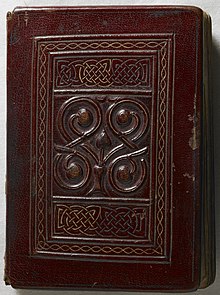
The St Cuthbert Gospel, also known as the Stonyhurst Gospel or the St Cuthbert Gospel of St John, is an early 8th-century pocket gospel book, written in Latin. Its finely decorated leather binding is the earliest known Western bookbinding to survive, and both the 94 vellum folios and the binding are in outstanding condition for a book of this age. With a page size of only 138 by 92 millimetres, the St Cuthbert Gospel is one of the smallest surviving Anglo-Saxon manuscripts. The essentially undecorated text is the Gospel of John in Latin, written in a script that has been regarded as a model of elegant simplicity.

A treasure binding or jewelled bookbinding is a luxurious book cover using metalwork in gold or silver, jewels, or ivory, perhaps in addition to more usual bookbinding material for book-covers such as leather, velvet, or other cloth. The actual bookbinding technique is the same as for other medieval books, with the folios, normally of vellum, stitched together and bound to wooden cover boards. The metal furnishings of the treasure binding are then fixed, normally by tacks, onto these boards. Treasure bindings appear to have existed from at least Late Antiquity, though there are no surviving examples from so early, and Early Medieval examples are very rare. They were less used by the end of the Middle Ages, but a few continued to be produced in the West even up to the present day, and many more in areas where Eastern Orthodoxy predominated. The bindings were mainly used on grand illuminated manuscripts, especially gospel books designed for the altar and use in church services, rather than study in the library.
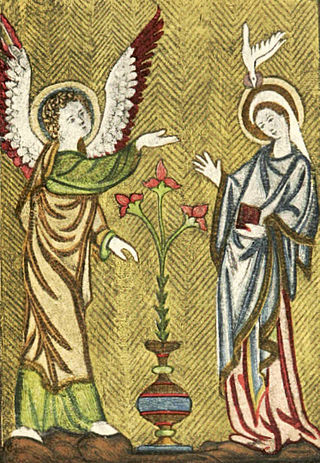
Opus Anglicanum or English work is fine needlework of Medieval England done for ecclesiastical or secular use on clothing, hangings or other textiles, often using gold and silver threads on rich velvet or linen grounds. Such English embroidery was in great demand across Europe, particularly from the late 12th to mid-14th centuries and was a luxury product often used for diplomatic gifts.
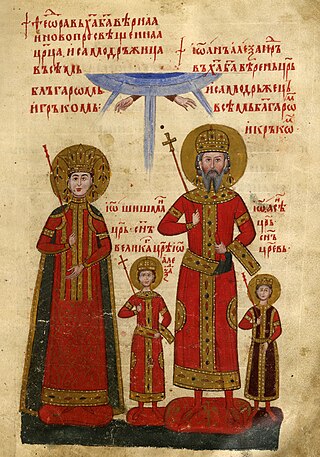
The Gospels of Tsar Ivan Alexander, Tetraevangelia of Ivan Alexander, or Four Gospels of Ivan Alexander is an illuminated manuscript Gospel Book, written and illustrated in 1355–1356 for Tsar Ivan Alexander of the Second Bulgarian Empire. The manuscript is regarded as one of the most important manuscripts of medieval Bulgarian culture, and has been described as "the most celebrated work of art produced in Bulgaria before it fell to the Turks in 1393".

The Parker Library is a library within Corpus Christi College, Cambridge which contains rare books and manuscripts. It is known throughout the world due to its invaluable collection of over 600 manuscripts, particularly medieval texts, the majority of which were bequeathed to the college by Archbishop of Canterbury Matthew Parker, a former Master of Corpus Christi College.
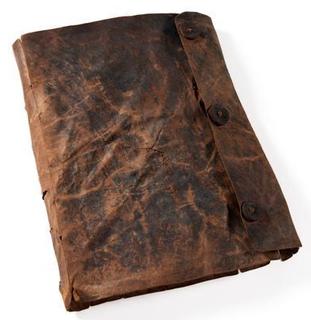
The Faddan More Psalter is an early medieval Christian psalter or text of the book of Psalms, discovered in a peat bog in July 2006, in the townland of Faddan More in north County Tipperary, Ireland. The manuscript was probably written in about 800 CE in one of a number of monasteries in the area. After several years of conservation work, the psalter went on display at the National Museum of Ireland – Archaeology in Kildare Street, Dublin in June 2011.

The Felbrigge Psalter is an illuminated manuscript Psalter from mid-13th century England that has an embroidered bookbinding which probably dates to the early 14th century. It is the oldest surviving book from England to have an embroidered binding. The embroidery is worked in fine linen with an illustration of the Annunciation on the front cover and an illustration of the Crucifixion on the back.

The British Library is a research library in London that is the national library of the United Kingdom. It is one of the two largest libraries in the world, along with the Library of Congress. It is estimated to contain between 170 and 200 million items from many countries. As a legal deposit library, the British Library receives copies of all books produced in the United Kingdom and Ireland, including a significant proportion of overseas titles distributed in the UK. The Library is a non-departmental public body sponsored by the Department for Digital, Culture, Media and Sport.

Bookbinding is the process of building a book of codex manuscripts from an ordered stack of paper sheets with one's hands and tools. Firstly, one binds the sheets of papers along an edge with a thick needle and strong thread. One can also use loose-leaf rings, binding posts, twin-loop spine coils, plastic spiral coils, and plastic spine combs, but they last for a shorter time. Next, one encloses the bound stack of paper in a cover. Finally, one places an attractive cover onto the boards, and features the publisher's information and artistic decorations.
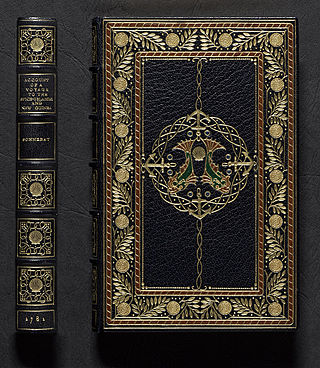
Sangorski & Sutcliffe is a firm of bookbinders established in London in 1901. It is considered to be one of the most important bookbinding companies of the 20th century, famous for its luxurious jeweled bindings that used real gold and precious stones in their book covers.

The King's Library was one of the most important collections of books and pamphlets of the Age of Enlightenment. Assembled by George III, this scholarly library of over 65,000 volumes was subsequently given to the British nation by George IV. It was housed in a specially built gallery in the British Museum from 1827 to 1997 and now forms part of the British Library. The term "King's Library" was until recently also used to refer to the gallery in the British Museum built for the collection, which is now called the "Enlightenment Gallery" and displays a wide range of objects relating to the Enlightenment.

The Queen Mary Psalter is a fourteenth-century English psalter named after Mary I of England, who gained possession of it in 1553. The psalter is noted for its beauty and the lavishness of its illustration, and has been called "one of the most extensively illustrated psalters ever produced in Western Europe" and "one of the choicest treasures of the magnificent collection of illuminated MSS. in the British Museum".

The Lindau Gospels is an illuminated manuscript in the Morgan Library in New York, which is important for its illuminated text, but still more so for its treasure binding, or metalwork covers, which are of different periods. The oldest element of the book is what is now the back cover, which was probably produced in the later 8th century in modern Austria, but in the context of missionary settlements from Britain or Ireland, as the style is that of the Insular art of the British Isles. The upper cover is late Carolingian work of about 880, and the text of the gospel book itself was written and decorated at the Abbey of Saint Gall around the same time, or slightly later.
Katharine Adams was a British bookbinder famous for her detailed leather bindings.
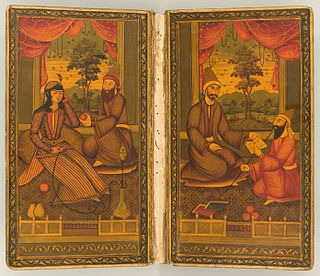
Doublures are ornamental linings on the inside of a book. Doublures are protected from wear, compared to the outside of a book, and thus offer bookbinders scope for elaborate decoration.

Ivor Robinson MBE was a British master craftsman and fine bookbinder, one of the most important of the late 20th century. He is particularly known for his mature work with gold-tooled lines on black leather. His work is held in high esteem, entering many public and private collections around the world, and fetching good prices at auction. He was also an influential teacher of bookbinding. He was awarded an MBE 'For Services to Bookbinding.'

George A. Baer was a German/Swiss/American bookbinder. He specialized in fine leather bindings, including inlays and gold tooling.
Sybil Pye was a self-trained British bookbinder famous for her distinctive inlay Art Deco leather bindings. She was, along with Katharine Adams and Sarah Prideaux, one of the most famous women bookbinders of their period. She was the only binder in England and one of a few in the world whose specialty was inlaid leather bindings.
William Nott was a 17th-century London bookbinder who has been tentatively identified as "Queen's Bookbinder A." Samuel Pepys reports in his diary in 1668 that he visited a bookbinder named Nott, likely William, and obtained a binding from him:
"...having sent for W. Howe to me to discourse with him about the Patent Office records, wherein I remembered his brother to be concerned, I took him in my coach with W. Hewer and myself towards Westminster; and there he carried me to Nott’s, the famous bookbinder, that bound for my Lord Chancellor’s library; and here I did take occasion for curiosity to bespeak a book to be bound, only that I might have one of his binding."
Christine Elizabeth Florence Greenhill was an English bookbinder. She did bookbinding following her encouragement from her sister to enrol on bookbinding classes until the Second World War broke out when she became a full-time air raid warden and thus had little time to do bookbinding. Greenhill returned to bookbinding soon after the war was over and served as honorary secretary of the Guild of Contemporary Bookbinders before being elected its president for a single term. The Bodleian Library has held two collections of boxes relating to her life and career in its Libraries Repository since 2009.
